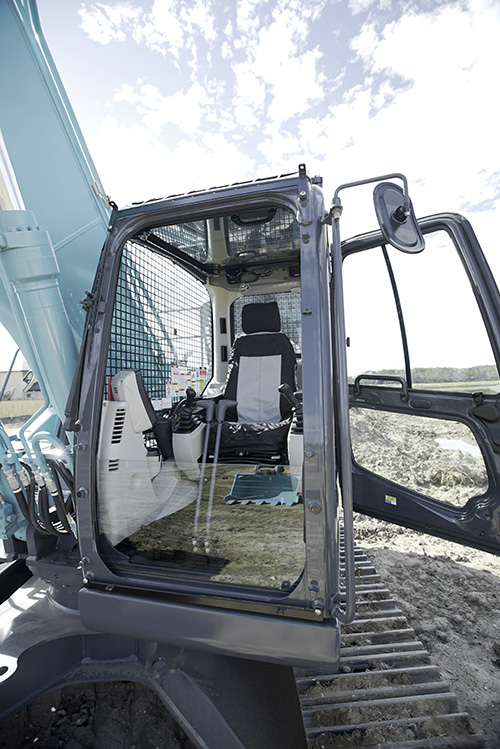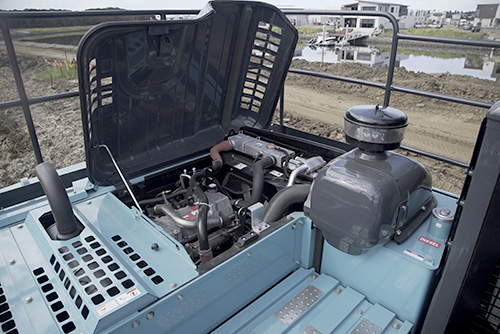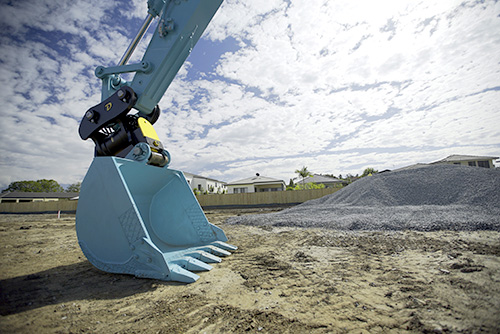EVARN COVICH hops behind the controls of a new 25.7-tonne Kobelco SK260LC-10 excavator on a Gold Coast worksite and says it ticks just about all the boxes
BROWSE ALL KOBELCO EXCAVATORS FOR SALE
I WAS asked recently to check out a new Kobelco SK260LC-10 excavator being delivered by BrisVegas Machinery to its new owner on a worksite at Hope Island on the Gold Coast, which I graciously accepted … after all, how often does the owner of a brand new machine give you the opportunity to put some dirt on it before they put it out to work and start to rack up some real hours on the clock?
After a quick site induction and briefing with Coops Drainage and Civil site foreman Ben, I was ready to jump in the driver’s seat of the company’s newest asset and put it to work to see how it performed!
Walkaround
The 25.7-tonne SK260LC-10 looks to be a pretty smart-looking piece of machinery at first glance with its grey cab along with a few other assorted items and the unmistakable blue/green that we all know to be Kobelco.
The colour proved to be a good thing because the Coops boys had already opted to remove the factory branding in favour of their own. I suppose the manufacturer always seems to take the best advertising real estate available on a new machine!
The climb onto the tracks is quite effortless with the use of the extra-long step situated along the side of the track frame. The ascent up onto the back of the machine has also been made easier thanks to the fuel tank being moved to the right hand side of the machine, which has also increased visibility to the offside of the machine from the driver’s seat.
The large standing area on top is also countersunk to enable easier access to the engine and air filter — you don’t have to bend down as far in order to check and work on them.
Lifting the light engine cover to reveal the turbo/intercooled 4 cylinder 5.123L Hino JO5E-TB motor, it is good to see the oil filler and dipstick positioned well for easy access.
There also looks to be a good amount of room around the engine in order to fit hands and arms during the course of repairs and maintenance.
The hydraulic oil sight glass and the fuel and oil filters are accessed at ground level through the right-hand-side door, negating the need to have to deal with hot engine parts and also affording more room for tool use.
The radiator, coolant reservoir bottle, batteries and isolator are accessed through the left-hand-side door.
The boom looks to be of sturdy construction with good, clean welds, and comes factory fitted with craning safety valves, auxiliary and quick-hitch piping.
A couple of modifications that could easily go unnoticed have been made to the dipper arm to help strengthen the connection to the boom as well as distribute the stress more evenly, which should increase lifespan.
The reach also looks pretty good at a tad over 10m, and grease nipples seem to be well positioned for easy access.
The track frame looks to be well made and is angled at the top in order to help the dirt slide off and make cleaning easier. Track guards are positioned along the bottom of the track frame to help stop movement and slippage off rollers, which can sometimes be an issue on long-carriage machines.
 |
|
Visibility from the Kobelco SK260LC-10 excavator’s cab is excellent.
|
In the cab
Getting in and out of the cab was fairly easy thanks to a good size cab and door. Inside the cab the seat felt good thanks to the air adjustments. I was able to slide it back enough to provide ample legroom for my 6-foot frame, and it can also be adjusted independently from the control levers to help you achieve your optimum operating position.
Vision from the operator’s seat was excellent with a large amount of glass afforded on this ROPS-rated cabin, especially on the right where a one-piece window takes up almost the whole wall.
The LCD dash is well situated and easy to read and understand. I particularly like that you can have the rear camera on without losing sight of the machines vitals and modes.
With the touch of a button you can access alternate screens to help you keep an eye on other data such as service times and fuel consumption.
There is not much in the way of switches other than worklights and quick hitch, with a couple more spaces available to fit more switches if required. All of these, along with the engine speed dial, are within easy reach of the operator; the other functions are operated via the LCD dash.
The climate control and AM/FM radio are situated below the operator’s right arm and are pretty straightforward to understand. I like that both units are sealed with touchpad operation so there are no holes, gaps or crevices for dust or moisture to invade and affect performance and operation.
A USB port for those wanting to listen to their own music or charge devices and a 12V power connection are also situated near the radio.
 |
|
The large standing area on top of the Kobelco SK260LC-10 excavator is countersunk to enable easier access to the engine and air filter.
|
On the job
Ben passed up my offer to go and take over from the machine laying pipes out the back of the site (just quietly, I think he might’ve had some trust issues!) instead opting to assign me the task of moving a stockpile of overburden soil in order to create some room for them to stockpile more rock and drainage material.
As the machine burst into life I quickly set about adjusting to my new environment, positioning seat and controls to my liking.
It was a fairly warm winter’s day, tipping the scales at around 24 degrees, so the cab was quite warm upon entering. I set the climate control at 20 degrees on auto mode and it quickly brought the temperature down inside the cab.
Travel speed felt good as I headed off to the soil stockpile with a cruising speed of 3.8km/h in turtle and 6.1km/h in rabbit. The machine moved around the site rather quickly, and also climbed the stockpile with ease — even though it was made up of damp, unsuitable material I was able to climb up without the need to pull myself up using the bucket.
As I started digging I was happy with the speed and smoothness of operation. I found the machine operated well in all the different mode settings, with the engine seeming to handle each situation each time I loaded it up with relative ease.
Stability was good. I heaped the bucket full of damp soil and proceeded to swing around at full stretch, stopping and starting a few times with the machine only feeling a bit tippy straight out over the side of the tracks — as you’d expect.
I spent a couple of hours throwing dirt around and performing a bit of precision trimming work, among other things, all the while feeling impressed with the overall performance of the machine.
 |
|
Evarn was impressed with the overall performance of the Kobelco SK260LC-10 excavator.
|
The bottom line
I was quite impressed with my time spent in the operator’s seat of the Kobelco SK260LC-10 excavator; in fact I would’ve liked to have spent a few more hours behind the controls if I had more time.
I found it to be powerful yet smooth to operate and pretty quick yet stable. I found the cab to be spacious, comfortable and operator friendly with excellent vision around the machine.
The controls were comfortable to hold and felt quite responsive. Kobelco says it has made the levers up to 38 percent lighter to operate in order to help reduce fatigue over long periods of time in the driver seat, so no more crying to the boss about how tired you are at the end of the week!
Proper climate control is always a plus for me. I like being able to set a temperature and get it throughout the shift without fluctuation. I hate it when a machine manufacturer claims to have climate control and you find you have to manually control it, resulting in inconsistent temperatures and distraction.
The boys at Coops informed me that they run a few different brands of excavators in their fleet but the company seemed to be steering more towards the blue/green machines these days as they claim to have experienced significant savings to overall running costs of their Kobelco fleet over the past few years compared to the other similar-sized machines that they operate.
I was also told that more of their operators prefer to operate the Kobelco machines as opposed to the others, which is good to hear considering these guys cover both bulk and precision work.
An added bonus is that Kobelco claim to have squeezed more fuel efficiency out of the new range of machines with the help of some changes made to the hydraulic system.
Larger pipes and less resistant bends and junctions are coupled with a new arm interflow system which uses the weight of the boom when lowered to force the hydraulic oil up into the dipper arm ram, reducing the amount of outside power required to move the arm out.
The ERG cooler, which lowers combustion temperature, and the common rail system that delivers a more precise injection of fuel to improve combustion efficiency all count towards Kobelco’s claim of around a 15 percent fuel saving on H and S modes and around a 20 percent saving in ECO mode.
AIS (Auto Idle Stop) is another cost-saving measure that will sound an alarm after 55 seconds when the hydraulic lockout lever is engaged, and then will shut the machine down 5 seconds after that if the lever is not disengaged.
This alone will probably save a few bucks for those machine owners who have that one operator who always likes to get off the machine and have a bit of a chat to anyone who’s willing to listen.
The only thing I could pick as a bit of a fault is the new position of the fuel filler, which is situated just behind the rear of the cab.
I think it’s a good thing that Kobelco has repositioned the fuel tank here as it has improved access onto the back of the machine as well as improved visibility to the offside of the machine. The drawback, however, is the possibility of spillage getting over the rear window of the cab and surrounding area while refuelling if one is not careful.
I feel a change in the position of the fuel filler could help alleviate this issue.
Overall this is a machine that I could quite happily operate on a daily basis. Added to all its features are digging power, speed and smoothness of operation … I feel this machine ticks all those boxes.
Photography: Nic Leggat






